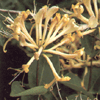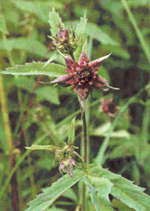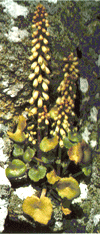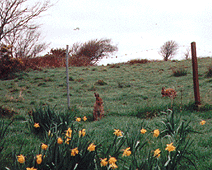

Much of Whiddy island is pasture land
and is relatively species poor although when fields are left for silage
production they are a riot of colour in late spring and early summer.
Of particular note is the 'giant rhubarb' (Gunnera tinctoria) a native
of south america which grows in abundance on the southern coast of Whiddy.
The leaves of this 'giant' can reach up to two metres across.
Another south american in residence is the Fuchsia (Fuchsia magellanica)
which is abundant on Whiddy and throughout S.W. Ireland
Kilmore lake is worth a look for the
yellow water lillies (Nuphar lutea) which are abundant and have a fragrance
like brandy!
The field walls are a haven for many species of fern and other plants-
in particular navelwort (Umbillicus rupestris) which can be seen in flower
throughout the summer. In late summer the display of 'Montbretia' along
many of the road sides is spectacular, bringing a wealth of colour when
many other plants have finished flowering.
There is a large population of mosses and liverworts in the wetter areas
and the majestic Royal fern (Osmunda regalis) a striking and unusual plant.
As a consequence of the clean air there is an abundance of lichens to
be found all over the island..
Marsh Cinquefoil
Potentilla palustris

Umbilicus rupestris

The otter (Lutra lutra) is present, but is very shy and wary of humans. If you see one it is something special! Many people mistake mink (Mustella vison) for otter.
Mink
are present here and you are much more likely to see a mink than an otter.
Grey seals (Halichoerus grypus) can be seen in the waters of the bay on occasion, but they tend to be shy and keep away from human contact.
There are good populations of many sea birds in the area and also many 'waders'.Flocks of Gannets (Sula bassana) are spectacular while feeding in the bay, diving from great heights to catch small fish.
Flocks of Curlew (Numenus
arquata) may be seen feeding in the fields on Whiddy in the winter and
spring.
While Choughs (Pyrrhocorax pyrrhocorax) can occasionally be seen, they
do not breed on Whiddy.